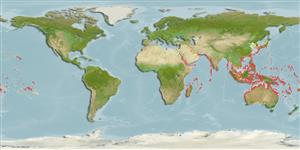Common names from other countries
Environment: milieu / climate zone / depth range / distribution range
экология
; пределы глубины 0 - 25 m (Ref. 348). Tropical
Indo-Pacific and the Mediterranean Sea: from East and South Africa, to eastern Polynesia; north to Japan and south to northern Australia.
Length at first maturity / Size / Вес / Возраст
Maturity: Lm ? range ? - ? cm Max length : 7.5 cm ShL самец/пол неопределен; (Ref. 348); common length : 6.0 cm SL самец/пол неопределен; (Ref. 348)
Attached to rocks and in crevices. Littoral and sublittoral to a depth of 25 m (Ref. 348). Found in intertidal reefs in rock pools and crevices (Ref. 377). Also found in sandy mudflats (Ref. 2925). Living in rock-pools and crevices of rocks at low-water mark, not common (Ref. 88739).
Life cycle and mating behavior
половая зрелость | размножение | нерест | икра | Fecundity | личинки
Members of the class Bivalvia are mostly gonochoric, some are protandric hermaphrodites. Life cycle: Embryos develop into free-swimming trocophore larvae, succeeded by the bivalve veliger, resembling a miniature clam.
Основная ссылка
ссылки | координатор | соавторы
Poutiers, J.M. 1998. (Ref. 348)
Статус Красного Списка МСОП (Ref. 130435)
Статус СИТЕС (Ref. 108899)
Not Evaluated
Not Evaluated
Угроза для людей
Harmless
Использование человеком
рыболовство: коммерческий
| FishSource |
инструменты
дополнительная информация
Возраст/Размеры
рост
Зависимость между длиной и массой тела
Зависимость между длинами
морфология
личинки
численность
ресурсы в Интернет
Estimates based on models
Preferred temperature
(Ref.
115969): 23.6 - 29.3, mean 28.3 (based on 3387 cells).
Уязвимость
Low vulnerability (10 of 100).
